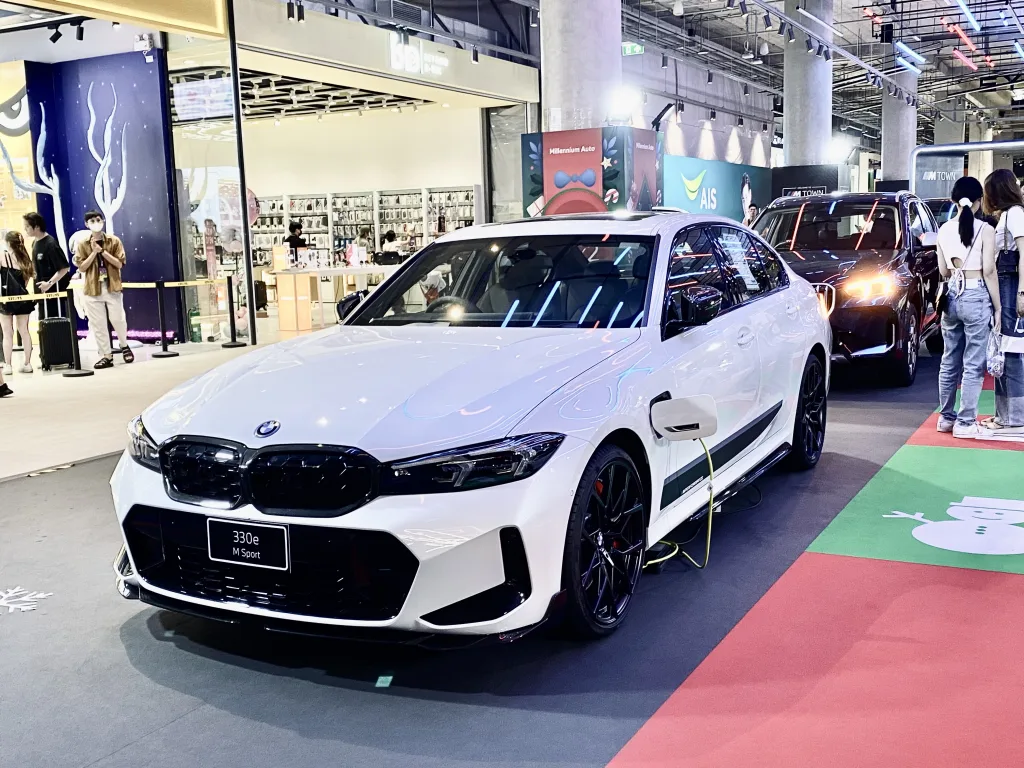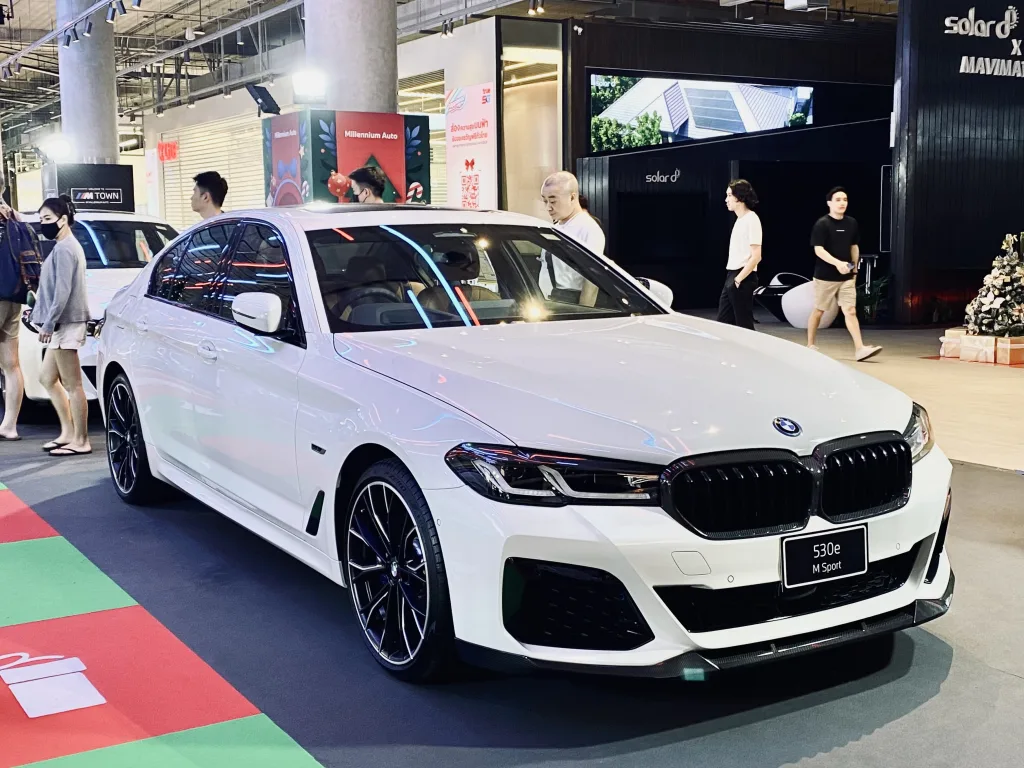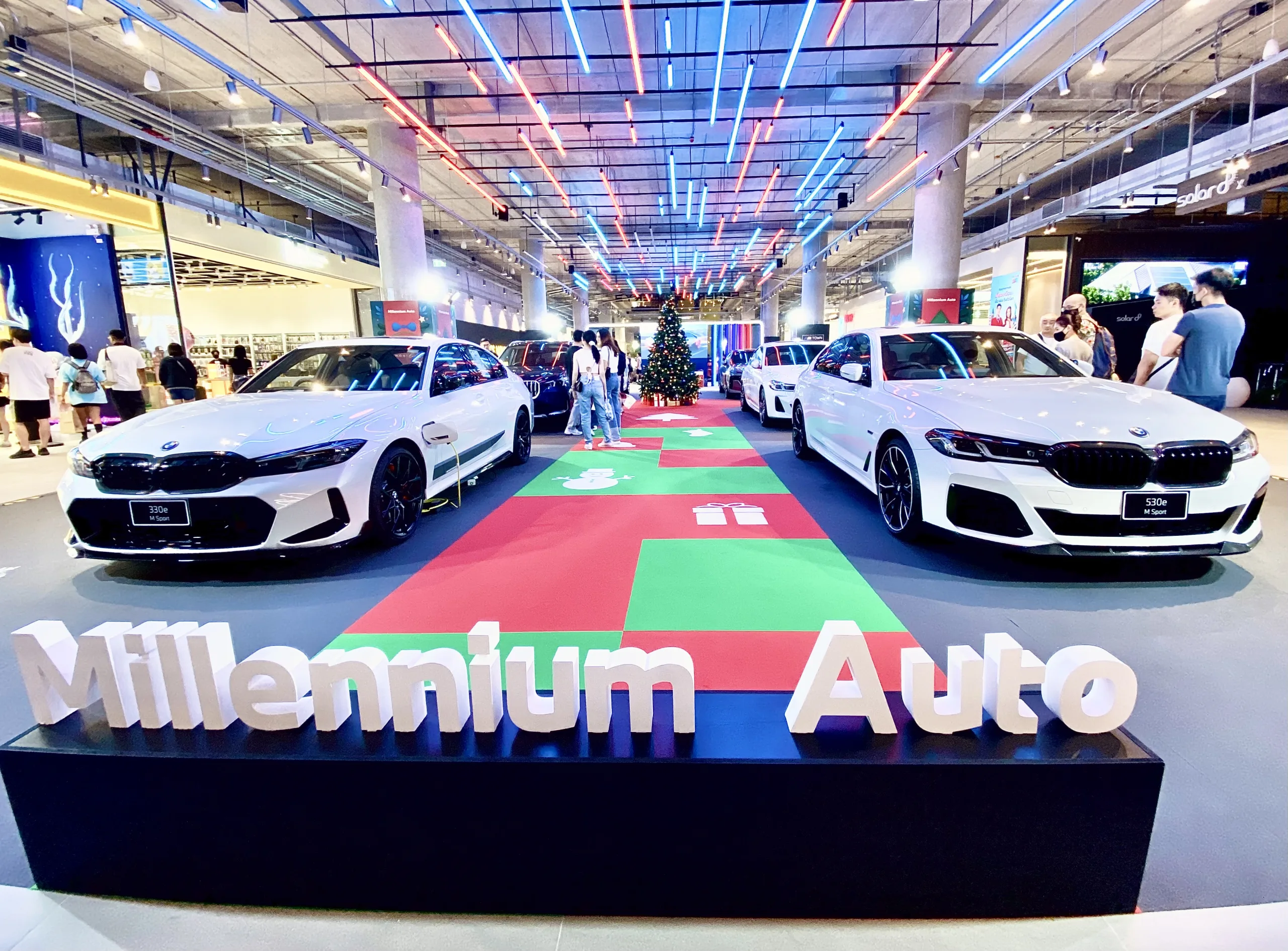As a car blogger, stepping into the Emsphere in Bangkok is like entering a futuristic wonderland where horsepower meets high fashion. I recently had the pleasure of attending the Millennium Auto car event on the 2nd floor of this architectural marvel that just flung open its doors to the public.
As I navigated through the interiors of the mall, the gleam of BMWs caught my eye. Parked right at the forefront were the BMW 330e Msport and 550e M Sport, basking in the ambient lighting like celebrities on the red carpet. The 330e Msport, with its aggressive stance and confident lines, whispered promises of adrenaline-pumping adventures.

BMW 330e M Sport
- Engine: 2.0-liter BMW TwinPower Turbo inline 4-cylinder, plug-in hybrid
- Power: 248 hp (combined system output)
- Torque: 310 lb-ft (combined system output)
- Transmission: 8-speed Sport Automatic transmission
- Acceleration (0-60 mph): Approximately 5.9 seconds
- Drive Type: Rear-wheel drive
- Battery: Lithium-ion with electric-only range of approximately 20-22 miles
- Fuel Efficiency: Enhanced by the electric motor, offering improved efficiency over conventional models
Right beside it, the 550e M Sport, the embodiment of luxury and performance, stood with an aura of sophistication.

- Engine: 2.0-liter BMW TwinPower Turbo inline 4-cylinder, plug-in hybrid
- Power: 288 hp (combined system output)
- Torque: 310 lb-ft (combined system output)
- Transmission: 8-speed Sport Automatic transmission
- Acceleration (0-60 mph): Approximately 5.7 seconds
- Drive Type: Available in both rear-wheel drive and all-wheel drive (xDrive)
- Battery: Lithium-ion with an electric-only range of approximately 20-30 miles depending on the model
- Fuel Efficiency: Significantly improved with the addition of the electric motor
The air was electric with excitement as enthusiasts and families alike gathered around, their eyes reflecting the cars’ shimmering surfaces. Children tugged at their parents’ hands, pointing excitedly, while seasoned aficionados discussed the fine engineering and design elements in animated tones. It was a mix of awe, aspiration, and pure joy.
The atmosphere was infectious, light-hearted banter filled the air, and laughter echoed off the high ceilings. It felt like a community brought together by a shared passion, and I found myself grinning from ear to ear. There’s something undeniably wholesome about seeing people of all ages light up at the sight of these magnificent machines.
As I made my rounds, the staff at the event were the epitome of professionalism, their enthusiasm matching the crowd’s. They were knowledgeable, approachable, and seemed to take genuine pleasure in sharing the BMW experience with everyone.
Now, let me take a moment to talk about what it feels like to be in the presence of these cars. The BMW 330e M sport is a statement. It’s for those who dare to dream and then chase those dreams. The 550e M Sport, on the other hand, is like a seasoned storyteller, each curve and contour narrating tales of innovation and luxury.
And as I left the event, I carried with me an afterglow of inspiration and a renewed appreciation for the art of automotive design. This wasn’t just a showcase; it was a celebration of craftsmanship, innovation, and the sheer joy of motoring.
So, dear readers, if you find yourself in Bangkok, make your way to the 2nd floor of the Emsphere mall. Visit Millennium Auto, and witness this spectacle for yourself. Whether you’re a car enthusiast or just looking for a dose of excitement, this is an experience you won’t want to miss. Trust me, it’s about the memories you’ll create and the stories you’ll tell. Join in, laugh, dream, and be a part of the auto extravaganza. See you there!
The history of cars is a fascinating journey of innovation, stretching back over a century. Here’s a brief overview:
- Early Innovations (Late 1700s to 1800s): The story of automobiles begins with early experiments in the late 18th century. Innovators like Nicolas-Joseph Cugnot and Richard Trevithick were among the first to construct steam-powered vehicles. However, these were quite different from the cars we know today, being large, cumbersome, and impractical for widespread use.
- Birth of the Modern Automobile (Late 1800s): The modern automobile era began in the late 19th century with key developments in Germany and France. Karl Benz created the Benz Patent-Motorwagen in 1886, often credited as the first true gasoline-powered car. At around the same time, other pioneers like Gottlieb Daimler and Wilhelm Maybach were also making significant advancements.
- Mass Production and Model T (Early 1900s): The automobile’s popularity soared with the introduction of mass production techniques, notably by Henry Ford. The Model T, introduced in 1908, revolutionized transportation and industry, making cars affordable and accessible to the general public. This period saw the establishment of many of today’s major car manufacturers.
- Innovation and Luxury (Mid 1900s): As the 20th century progressed, cars became not just means of transportation but symbols of status and freedom. Technological advancements introduced improved engines, safety features, and designs. Luxury brands and sports cars began to emerge, shaping the automotive landscape.
- Japanese Manufacturers and Oil Crisis (1960s-1970s): Post-WWII, Japanese manufacturers like Toyota and Honda rose to prominence, known for their fuel efficiency and reliability. The oil crisis of the 1970s further shifted focus towards smaller, more efficient vehicles, pushing innovation in fuel economy.
- Technological Advancements (1980s to 2000s): Advancements in technology introduced features like electronic fuel injection, safety improvements, and more efficient engines. The industry also began to focus on environmental concerns, leading to the development of hybrid and electric vehicles.
- Electric Revolution and Autonomous Cars (21st Century): The early 21st century has seen a significant shift towards electric vehicles, led by companies like Tesla. Concerns over climate change and technological advancements are driving the development of fully electric and hybrid models. Additionally, the development of autonomous or self-driving cars is set to redefine the future of transportation.

Leave a Reply